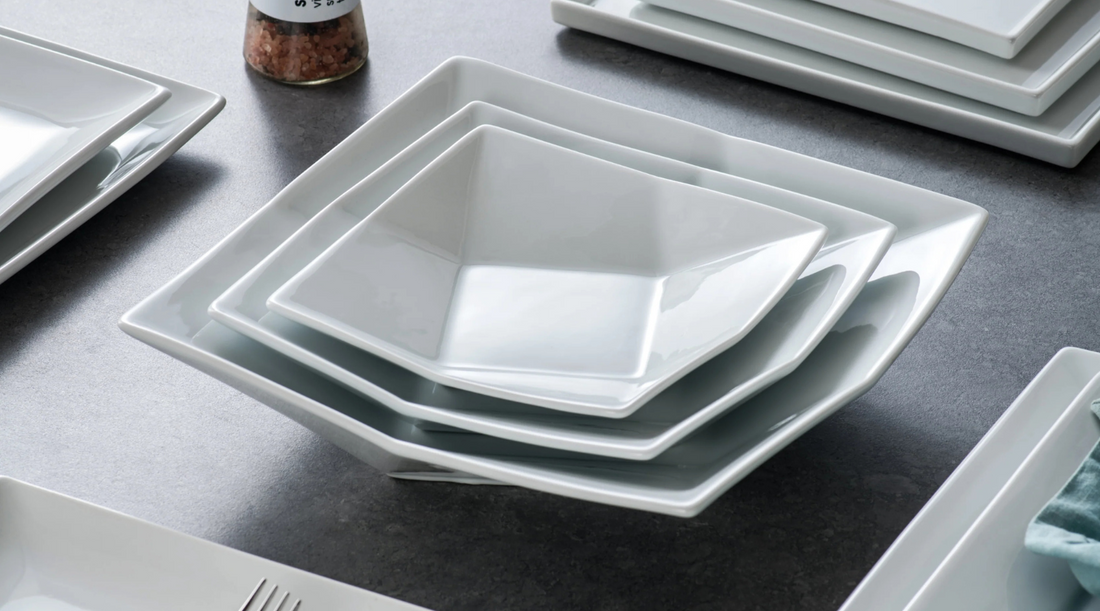
What Are the Hidden Costs of Ordering Wholesale Restaurant Plates
When you're running a restaurant, the price tag on wholesale restaurant plates is only the starting point. There are a lot of other expenses to consider. Think about the costs of maintaining, storing, and replacing your tableware.
These hidden costs can end up doubling or even tripling your investment, making it really important to plan ahead.
The Real Cost of Breakage and Replacement
Plate breakage is a major expense that restaurant owners often overlook. Porcelain dinnerware typically needs to be replaced anywhere from 50% to 150% a year. This means you might have to swap out your entire inventory every 6-12 months. That adds up to a lot of extra costs.
Replacing dinnerware is a constant expense that can add up and really strain your finances. A restaurant serving 1,000 plates, the numbers add up. You initially shell out $5,000 for 1,000 porcelain round plates at $5 a pop. Every year, you're likely looking at $2,500 to $7,500 in replacement costs.
And that's not even counting the labor time and potential risks to staff and customers.
Material choice is a big deal. With melamine dinnerware, the upfront cost is pretty similar, but the replacement rate takes a nosedive to 10-20% each year. If you invest in 1,000 plates, you'll only be looking at $500-$1,000 in replacement costs annually.
Storage and Space Requirements Drive Up Overhead
Buying plates in bulk means needing a lot of storage space. Restaurant storage space usually runs between $15 and $25 per square foot per year. To give you an idea, storing enough plates can take up a big chunk of space.
Space needs add up quickly. Commercial plate storage containers run $50-200 each, and you'll want multiple units. For a restaurant seating 100, you're looking at 3-5 storage units to store your plate collection.
Transportation and handling gear are often overlooked. Plate storage trolleys can cost $190-270 each. Such small purchases can quickly add up to big overhead costs.

Minimum Order Quantities Create Cash Flow Challenges
Wholesale suppliers often set minimum order quantities (MOQs) as low as 500 or as high as 10,000 pieces. This leads to extra costs that might not be immediately apparent.
The cash flow hit can be big when MOQs involve paying $5,000 to $50,000 or more. This upfront cost can be tough for restaurant owners to swallow, especially during slow seasons.
Inventory carrying costs are more than just storage fees - they also include insurance and the missed opportunities. Experts say these costs typically range from 8-12% of your inventory's value each year. To put that in perspective, if you have $20,000 worth of plates on hand, you can expect to pay around $1,600-$2,400 annually.
Having a lot of inventory on hand increases the risk of it becoming obsolete. Changes to your menu or branding efforts can make some of your investment useless.
Shipping and Logistics Fees Add Unexpected Expenses
Wholesale restaurant plates can add a pretty big chunk to your bill - 10-25% of your total - just for shipping. That's because these plates are super heavy and fragile, so they need to be handled with care. This special handling makes shipping them more expensive.
Here's a breakdown of common shipping-related hidden costs:
|
Cost Type |
Typical Range |
Impact on $10,000 Order |
|
Base Shipping |
5-15% |
$500 - $1,500 |
|
Handling Fees |
2-5% |
$200 - $500 |
|
Insurance |
1-2% |
$100 - $200 |
|
Expedited Delivery |
3-8% |
$300 - $800 |
|
Total Additional |
11-30% |
$1,100 - $3,000 |
Damaged goods are a major concern. Insurance helps, but dealing with damaged shipments still causes delays and operational issues.
Quality Control and Warranty Limitations
Wholesale plate warranties usually don't cover much. They also don't cover breakage or misuse. This can lead to unexpected costs if the plates don't last.
Quality issues between batches can lead to a full inventory swap, just to keep things looking good. Restaurant owners say they shell out 5-10% of their tableware budget each year for replacement items.
Warranty claim processing takes up time and also incurs costs for documentation and shipping. Even when claims are successful, they can still cost $50-200.

Labor and Operational Hidden Costs
Training your staff on how to properly handle new tableware can cost around $25-50 per person. And the thing is, you'll have to keep repeating this training for new employees. Let's say you're a restaurant with 20 employees and half of them leave each year. That's $500-1,000 a year just on training.
Dishwashing and upkeep costs differ a lot. Porcelain needs to be handled carefully and cleaned in a specific way. If you don't handle them right, it can increase breakage. That means you'll spend more on replacements.
Managing inventory gets a lot more complicated when you're buying in bulk. Restaurants often spend between $500 and $2,000 on systems that help track what's being used and what needs to be replaced.
Seasonal and Market Fluctuations
Changing prices of raw materials can really throw a wrench into replacement costs. Ceramic and melamine prices tend to swing a bit every year due to petroleum costs going up or down, and manufacturing capacity. If a restaurant is stuck with a certain plate style, it might end up paying a lot more to replace it.
Seasonal fluctuations can make things more complicated. During slow times, many suppliers give better deals, but they hike up prices during peak periods. If restaurants don't plan ahead, they might have to buy replacements at a higher price.
For restaurant owners shopping around for wholesale restaurant plates, it's essential to know about these extra costs. At Palate & Plate, we only work with businesses, making sure everything about buying tableware is upfront. We want our partners to know the real costs involved before spending big.
To weigh the pros and cons of wholesale buying, our guide on wholesale plates for restaurants vs retail can give you a better idea of how to keep costs down.
Minimizing Hidden Costs Through Strategic Planning
Planning ahead can save you a lot of money. First, figure out what you really need. Consider how many seats you have and what kind of service you offer. As a rule of thumb, most places need at least 2-3 plates per seat.
The material you choose can have a big impact on your expenses. While porcelain looks amazing, melamine is incredibly durable. When deciding, consider your service style and what your customers expect.
Check out deals that include storage solutions and replacement guarantees. Many suppliers offer a discount when you buy a complete tableware package.

To Sum Up
Knowing the real costs of wholesale restaurant plates is crucial for restaurant owners. Breakage, storage, and shipping costs add up, so it's a good idea to factor them in. The right material and a plan for replacements can make a big difference. Also, consider the ups and downs of seasonal demand and order quantities.
At Palate & Plate, we're all about being upfront and helping with your tableware needs. Check out our website to find options that work for your restaurant.
Frequently Asked Questions
What percentage of restaurant plates typically need replacement annually?
Porcelain plates usually need to be replaced every year. In contrast, durable melamine plates only require replacement at a much lower rate. This makes choosing the right material important.
How much storage space do wholesale plate orders typically require?
A typical restaurant usually needs around 100-200 square feet for storing wholesale plates. This can cost around $1,500-5,000 per year.
What are typical minimum order quantities for wholesale restaurant plates?
Wholesale suppliers usually have minimum orders of 500-10,000 pieces. This can be tough for cash flow.
How much do shipping costs typically add to wholesale plate orders?
The total cost of your wholesale plate purchase will likely be 10-25% higher once shipping and handling fees are added. You might also want to consider extra costs for insurance and protection against freight damage.
What warranty coverage can restaurants expect on wholesale plates?
Typically, wholesale plate warranties last anywhere from 30 days to a year, but they only cover defects in manufacturing. They don't include damage from normal wear and tear.
